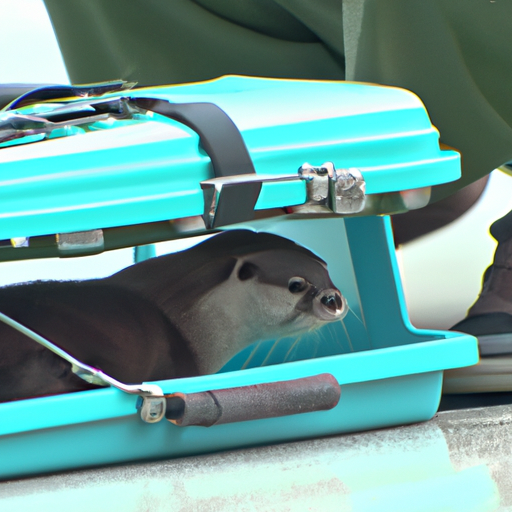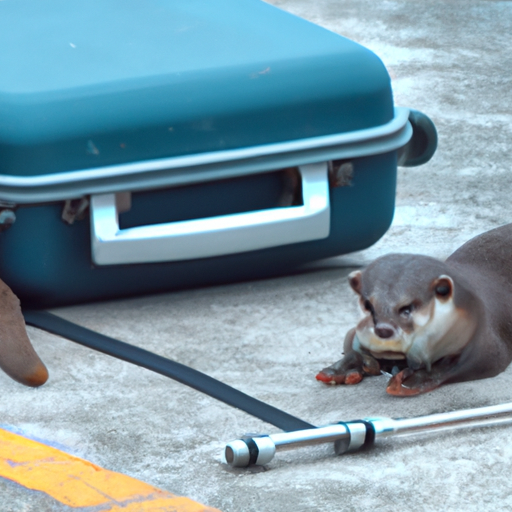
The Impact of Illegal Wildlife Trafficking on Biodiversity Conservation Efforts
Illegal Wildlife Trafficking: Traveler Caught Smuggling Otters, Rats, and Snakes on Flight to Taiwan
Illegal wildlife trafficking is a global issue that poses a significant threat to biodiversity conservation efforts. Recently, a traveler was apprehended at an airport in Taiwan for attempting to smuggle a variety of animals, including otters, rats, and snakes. This incident highlights the detrimental impact that such activities have on our natural ecosystems.
Biodiversity conservation is crucial for maintaining the delicate balance of our planet’s ecosystems. It involves protecting and preserving the variety of plant and animal species that coexist in different habitats. However, illegal wildlife trafficking undermines these efforts by disrupting the natural order and causing irreparable damage to our environment.
The incident in Taiwan serves as a stark reminder of the extent to which illegal wildlife trafficking can harm biodiversity. Otters, for example, play a vital role in aquatic ecosystems by controlling populations of fish and invertebrates. Smuggling them out of their natural habitats disrupts this delicate balance and can lead to the collapse of entire ecosystems.
Similarly, rats, although often considered pests, serve important ecological functions. They are scavengers that help decompose organic matter, contributing to nutrient cycling in ecosystems. When rats are removed from their natural habitats through illegal trafficking, the consequences can be far-reaching, affecting the health and stability of ecosystems.
Snakes, too, are integral to maintaining biodiversity. They play a crucial role in controlling rodent populations, thus preventing outbreaks of diseases and maintaining the balance of prey and predator relationships. When snakes are taken from their natural habitats and sold on the black market, it disrupts these delicate ecological interactions, leading to potential ecological imbalances.
The impact of illegal wildlife trafficking extends beyond the immediate loss of individual species. It also has broader implications for the overall health and resilience of ecosystems. When certain species are removed from their natural habitats, it can create a domino effect, causing a cascade of negative consequences throughout the ecosystem.
Furthermore, illegal wildlife trafficking often involves cruel and inhumane practices. Animals are often captured using brutal methods, transported in cramped and unsanitary conditions, and subjected to extreme stress. Many do not survive the journey, and those that do often suffer from physical and psychological trauma. This not only raises ethical concerns but also highlights the need for stricter enforcement and penalties to deter such activities.
To combat illegal wildlife trafficking effectively, a multi-faceted approach is necessary. This includes strengthening legislation and law enforcement, raising public awareness, and promoting sustainable alternatives. It is crucial to educate travelers about the consequences of their actions and encourage them to report any suspicious activities they may encounter during their journeys.
Additionally, international cooperation is vital in tackling this global issue. Countries must work together to share information, intelligence, and best practices to disrupt the networks involved in illegal wildlife trafficking. By collaborating, we can enhance our ability to detect, intercept, and prosecute those involved in these illicit activities.
In conclusion, the recent incident in Taiwan serves as a stark reminder of the detrimental impact of illegal wildlife trafficking on biodiversity conservation efforts. It disrupts ecosystems, threatens the survival of species, and undermines the delicate balance of our planet’s natural habitats. To protect our environment and preserve biodiversity, it is crucial that we take immediate action to combat this global issue. By raising awareness, strengthening legislation, and promoting international cooperation, we can work towards a future where wildlife trafficking is eradicated, and our natural ecosystems thrive.
The Role of Airports in Combating Illegal Wildlife Trafficking

Illegal Wildlife Trafficking: Traveler Caught Smuggling Otters, Rats, and Snakes on Flight to Taiwan
Airports play a crucial role in combating illegal wildlife trafficking, as they serve as major transit points for smugglers attempting to transport endangered animals across borders. Recently, a traveler was apprehended at an airport in Taiwan, attempting to smuggle otters, rats, and snakes on a flight. This incident highlights the importance of airports in detecting and preventing such illegal activities.
Airports are often the first line of defense against wildlife trafficking, as they have the necessary infrastructure and security measures in place to identify and intercept smuggled animals. With millions of passengers passing through airports every day, it becomes imperative for airport authorities to remain vigilant and actively participate in efforts to combat this illicit trade.
One of the key ways airports contribute to the fight against wildlife trafficking is through the use of advanced screening technologies. X-ray machines and scanners are employed to inspect luggage and cargo, enabling authorities to identify any suspicious items that may contain smuggled animals. These technologies have proven to be highly effective in detecting hidden compartments or unusual shapes that may indicate the presence of wildlife.
In addition to technological advancements, airports also rely on the expertise of trained personnel to identify and apprehend wildlife smugglers. Customs officers and security personnel undergo specialized training to recognize the signs of illegal wildlife trafficking. They are trained to identify specific species, understand their behavior, and detect any attempts to conceal them. This knowledge is crucial in identifying smugglers who may use various methods to hide animals, such as sedating them or disguising them as common items.
Collaboration between airports and wildlife conservation organizations is another vital aspect of combating illegal wildlife trafficking. Many airports have established partnerships with local and international organizations to share information, intelligence, and best practices. These collaborations help in developing effective strategies to detect and prevent wildlife smuggling. By working together, airports and conservation organizations can leverage their resources and expertise to tackle this global issue.
Furthermore, airports play a crucial role in raising awareness among travelers about the consequences of wildlife trafficking. Through informative displays, brochures, and announcements, airports educate passengers about the importance of protecting endangered species and the legal consequences of participating in wildlife smuggling. This awareness helps in creating a sense of responsibility among travelers and encourages them to report any suspicious activities they may witness.
While airports have made significant progress in combating illegal wildlife trafficking, there is still much work to be done. Smugglers are constantly evolving their methods to evade detection, making it essential for airports to stay one step ahead. Continued investment in advanced screening technologies, training programs, and collaborations with conservation organizations is crucial to effectively combat this illicit trade.
In conclusion, airports play a vital role in combating illegal wildlife trafficking. Through the use of advanced screening technologies, trained personnel, collaborations with conservation organizations, and raising awareness among travelers, airports contribute significantly to the detection and prevention of wildlife smuggling. However, ongoing efforts and investments are necessary to stay ahead of the ever-evolving tactics employed by smugglers. By working together, we can protect our precious wildlife and ensure a sustainable future for all species.
The Need for International Cooperation to Combat Illegal Wildlife Trafficking
Illegal wildlife trafficking is a global issue that continues to plague our planet. It not only poses a threat to the survival of various species but also undermines the delicate balance of ecosystems worldwide. Recently, a shocking incident occurred when a traveler was caught smuggling otters, rats, and snakes on a flight to Taiwan. This incident serves as a stark reminder of the urgent need for international cooperation to combat this illegal trade.
The illegal wildlife trade is a lucrative business, estimated to be worth billions of dollars annually. It involves the illegal capture, trade, and sale of various endangered species, their parts, and products derived from them. This illicit trade is driven by demand for exotic pets, traditional medicines, and luxury goods made from animal parts. Unfortunately, this demand is fueled by a lack of awareness and enforcement, making it a highly profitable and low-risk venture for criminals.
To effectively combat illegal wildlife trafficking, international cooperation is crucial. This issue transcends borders, and no single country can tackle it alone. Cooperation between countries is essential to share intelligence, resources, and expertise. By working together, nations can strengthen their efforts to combat this illicit trade and protect vulnerable species.
One of the key aspects of international cooperation is the sharing of intelligence. Wildlife trafficking networks are complex and often span multiple countries. By sharing information about smuggling routes, key players, and emerging trends, countries can better target their enforcement efforts. This collaboration can help identify and dismantle criminal networks involved in the illegal wildlife trade.
Furthermore, international cooperation allows for the pooling of resources. Many countries face resource constraints when it comes to combating wildlife trafficking. By working together, countries can share equipment, technology, and personnel to enhance their enforcement capabilities. This can include the use of advanced surveillance systems, sniffer dogs, and specialized training for law enforcement officials.
Another important aspect of international cooperation is capacity building. Many countries lack the necessary expertise and infrastructure to effectively combat wildlife trafficking. By collaborating with more experienced nations, these countries can develop their own capabilities to tackle this issue. This can involve training programs, knowledge sharing, and the establishment of specialized units dedicated to combating wildlife trafficking.
Additionally, international cooperation can help address the demand side of the illegal wildlife trade. Consumer countries play a significant role in driving the demand for exotic pets, traditional medicines, and luxury goods made from animal parts. By working together, countries can raise awareness among their citizens about the negative impacts of the illegal wildlife trade. They can also implement stricter regulations and penalties to deter potential buyers.
In conclusion, the recent incident of a traveler caught smuggling otters, rats, and snakes on a flight to Taiwan highlights the urgent need for international cooperation to combat illegal wildlife trafficking. This illicit trade threatens the survival of various species and disrupts ecosystems worldwide. By sharing intelligence, pooling resources, and building capacity, countries can enhance their efforts to combat this illegal trade. Furthermore, addressing the demand side of the trade is crucial to reducing the profitability of wildlife trafficking. Only through international cooperation can we hope to protect our planet’s precious wildlife and preserve the delicate balance of nature.


